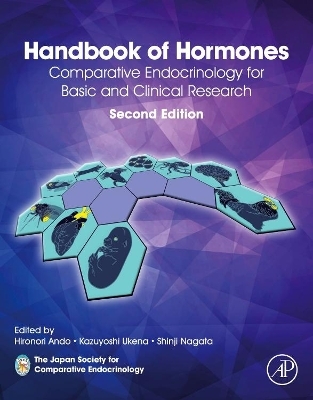
Handbook of Hormones
Academic Press Inc
978-0-12-820649-2 (ISBN)
Comparative endocrinology continues to rapidly expand and new information about hormones is being produced almost daily, making it important to stay up-to-date. Hormone, paracrine, and autocrine factors have been identified as key players in a range of different systems, including immune, musculoskeletal and cardiovascular. Frontiers between disciplines are being blurred and many scientists in fields other than endocrinology are interested in hormones. Scientists now have the unprecedented opportunity to look from invertebrates to vertebrate and identify novel regulatory factors and understand their function and how they determine an organism’s physiology and survival.
Sado Marine Biological Station, Faculty of Science, Niigata University, Niigata, Japan. His specific research interest involves neuroendocrine regulation of behavioral and physiological functions in diadromous migratory fish, such as salmonids and puffer fish. Graduate School of Integrated Arts and Sciences, Hiroshima University, Hiroshima, Japan. Professor Ukena discovered NPGL, a brain chemical that regulates hunger and fat storage in mammals, shows that hunger and energy consumption mechanisms are even more complex than we realized and has broad clinical and societal implications for the study and treatment of obesity and its associated diseases. Graduate School of Frontier Science, The University of Tokyo, Chiba, Japan. His research interests incluces regulatory mechanisms of feeding behavior in insects at a molecular level. In the laboratory, they use insects to understand the underlying strategies used by animals to survive. A number of the techniques and devices required for such investigation are available for use, including the purification of biologically active compounds, protein and peptide purification, molecular cloning, intracellular signaling, and bioimaging.
PART I PEPTIDES AND PROTEINS IN VERTEBRATES Molecule Evolution of Peptide and Protein Hormones in Vertebrates Section I.1. Neuropeptides 1. RFamide Peptide Family; 2. Corticotropin-Releasing Hormone Family; 3. Gonadotropin-Releasing Hormone; 4. Thyrotropin-Releasing Hormone; 5. Somatostatin/Neuronostatin; 6. Neurohypophysial hormone family; 7. Opioid Peptide Family; 8. Agouti Family; 9. Tachykinin Family; 10. Appetite-Regulating Peptides; 11. Urotensin II; 12. Neurotensin; 13. Neuromedin U/S /Precursor-related peptide; 14. Neuropeptide S; 15. Neuropeptide W; 16. Neuroendocrine Regulatory Peptide; 17. Neurosecretory peptide GL/GM; 18. Nesfatin-1; 19. Mexneurin; 20. Phoenixin
Section I.2. Adenohypophysial Hormones 21. Glycoprotein Hormone Family; 22. Growth Hormone/Prolactin Family; 23. Proopiomelanocortin Family
Section I.3. Gastrointestinal Hormones 24. Glucagon Family; 25. Secretin (Pituitary Adenylate Cyclase-Activating Polypeptide) Family; 26. Insulin Family; 27. Gastrin Family; 28. Ghrelin_Motilin Family; 29. Bombesin-Like Peptide Family; 30. Guanylin Family; 31. Galanin Peptide Family; 32. Neuropeptide Y Family; 33. Chromogranin A/Pancreastatin; 34. Xenin
Section I.4. Parathyroid Gland, Ultimobranchial Gland, and Stannius Corpuscle Hormones 35. Parathyroid Hormone Family; 36. Calcitonin/Calcitonin Gene-Related Peptide Family; 37. Stanniocalcin; 38 Cytokines; 39 Hematopoietic growth factors; 40 Cell proliferation factors; 41 Neurotrophins
Section I.6. Other Peripheral Hormones 42. Renin-Angiotensin System; 43. Kallikrein-Kinin System; 44. Apelin; 45. ELABELA; 46. Natriuretic Peptide Family; 47. Gonadal Hormones; 48. Adipocyte Hormones; 49. Endothelin; 50. Irisin; 51. Osteopontin; 52. Osteocrin; 53. Hepcidin/Liver-expressed antimicrobial peptide 1; 54. Salusin; 55. Adropin; 56. Lipocalin-2
PART II PEPTIDES AND PROTEINS IN INVERTEBRATES Section II.1. Neuropeptides Related to Vertebrate Hormones 57. Gonadotropin-Releasing Hormone-Like Peptide Family; 58. Corticotropin-Releasing Factor-Like Peptide; 59. Oxytocin/Vasopressin Superfamily; 60. Neuropeptide F; 61. Short Neuropeptide F; 62. RYamide; 63. Tachykinin-Like Peptide Family; 64. Insulin Superfamily; 65. Sulfakinin; 66. Cionin; 67. Ci-Galanin-Like Peptide; 68. Allatostatin-C; 69. Calcitonin-like Diuretic Hormone; 70. Ascidian calcitonin; 71. Amphioxus calcitonin family peptide; 72. Achinoderm calcitonin family peptide
Section II.2. Invertebrate-Unique Peptides 73. FXPRLamide Peptide Family; 74. Crustacean Hyperglycemic Hormone; 75. Ion Transport Peptide; 76. Prothoracicotropic Hormone; 77. Bursicon; 78. Allatotropin; 79. Allatostatin-A; 80. Adipokinetic Hormone; 81. Neuroparsin; 82. Ovary Maturating Parsin
Subsection II.2.2 Regulation of Myo/Cardio-Activities 83. LF Peptides; 84. Invertebrate Kinins; 85. FMRFamides; 86. Myoinhibiting Peptide; 87. Myosuppressin; 88. Proctolin; 89. Orcokinins; 90. Crustacean Cardioactive Peptide; 91. Cardioacceleratory Peptide 2b; 92. Achatina Cardio-Excitatory Peptide-1; 93. Fulicins; 94. Buccalins; 95. Eisenia Inhibitory Pentapeptides; 96. GGNG Peptides
Subsection II.2.3 Regulation of Behaviors 97. Eclosion Hormone; 98. Ecdysis Triggering Hormone; 99. Sex Peptide; 100. APWGamide; 101. SIFamide; 102. Egg-Laying Hormone
Subsection II.2.4 Other Hormones and Neuropeptides 103. Growth Blocking Peptide; 104. Yamamarin; 105. CCHamide; 106. Corazonin; 107. Trypsin-Modulating Oostatic Factor; 109. Pigment Dispersing Hormone; 110. GLWamide; 111. Hym-176; 112. Hym-301; 113. Leech Osmoregulatory Factor; 114. Ciona YFV/L peptide
PART III LIPOPHILIC HORMONES IN VERTEBRATES 115. Thyroid Hormones; 116. Gonadal Steroids; 117. Corticosteroids; 118. Neurosteroids; 119. Vitamin D Derivatives
PART IV LIPOPHILIC HORMONES IN INVERTEBRATES 120. Ecdysteroids; 121. Juvenile Hormone; 122. Methyl Farnesoate
PART V ENDOCRINE DISRUPTING CHEMICALS 123. Endocrine Disruptors; 124. Anti-Thyroid Hormone Active Chemicals
PART VI Amines and Amino Acids 125 Amines; 126 Amino Acids; 127 Acetylcholine
PART VII GASOTRANSMITTERS 128. Gasotransmitter Family
| Erscheint lt. Verlag | 28.7.2021 |
|---|---|
| Verlagsort | San Diego |
| Sprache | englisch |
| Maße | 216 x 276 mm |
| Gewicht | 3130 g |
| Themenwelt | Medizinische Fachgebiete ► Innere Medizin ► Endokrinologie |
| Studium ► 1. Studienabschnitt (Vorklinik) ► Biochemie / Molekularbiologie | |
| Naturwissenschaften ► Biologie ► Genetik / Molekularbiologie | |
| ISBN-10 | 0-12-820649-7 / 0128206497 |
| ISBN-13 | 978-0-12-820649-2 / 9780128206492 |
| Zustand | Neuware |
| Haben Sie eine Frage zum Produkt? |